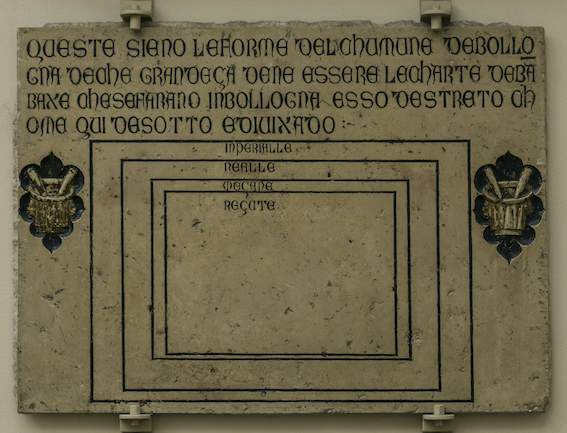The Lapidary of the Civic Medieval Museum of Bologna goes on the web: in fact, the new “scenario” of the portal History and Memory of Bologna, the digital project launched in 2014 by the Civic Museum of the Risorgimento | Istituzione Bologna Musei to make accessible to all web users a collective memory on the historical events that affected the city and its metropolitan area in the period between the Napoleonic age and the Liberation of 1945, is dedicated precisely to the Lapidary. The tool was designed with the aim of responding to the public demand for history and memory about periods and events of the past, knowledge of which is essential for understanding the present time. The new chapter, which complements the seven already available for consultation, respectively focusing on Certosa di Bologna, World War I, Liberation Struggle 1943-45, Bologna in the Nineteenth Century, City Tombstones and the aforementioned Papal Government, can be reached at www.storiaememoriadibologna.it/lapidario-museo-civico-medieval.
After the thematic focus on the memory of the centuries-old Papal Government in the city felsinea, retraced through the 188 coats of arms that decorate the majestic Sala Urbana of Palazzo d’Accursio, the scientific collaboration with the Civic Museums of Ancient Art in the enhancement of the city’s historical-artistic heritage is renewed with a monographic in-depth study of the collection of forty-one epigraphs of different periods and uses, mainly from the urban area of Bologna, formed mainly between the late 19th and early 20th centuries, in the post-Risorgimento historical phase in which the form of the “civic museum” as a new component of the Italian museum system was being institutionalized in Italy. The rich and varied exemplification documented by this corpus of artifacts allows the public to approach topics of great relevance and interest, such as the relationship between graphic phenomena and the public space of the city, with its implications from not only a formal but also a symbolic and ideological point of view, and the evolution of writing and the work that produces it in the monumental sphere.
The Lapidary’s collection includes materials of a heterogeneous nature, mainly from the urban area of Bologna, acquired as a result of renovations of churches and monuments, excavations or demolitions of buildings and city walls, and donations. The most relevant nucleus consists of 41 stone artifacts including epigraphs and cippus (31) and coats of arms (10), datable to a time span between the early Middle Ages and the 17th century, which is particularly notable for the recurrence of inscriptions relating to the professions and activities of organized societies and communities, especially secular ones.
Starting with the fundamental studies of Bruno Breveglieri, former professor of Diplomatics at the “Carlo Bo” University of Urbino and curator of the current exhibition arrangement of the Museo Civico Medievale’s Lapidario, a sheet has been prepared for each tombstone containing information on its original use, destination and users, as well as a photographic reproduction. Latin and Hebrew inscriptions have been transcribed and translated, where necessary also annotated. Based on these distinctive elements, the artifacts have been grouped into five thematic categories, also reproduced in the online scenario: Early Medieval and Gothic testimonies, Sepulchral epigraphs, Coats of arms, Fifteenth- and Seventeenth-century epigraphs, and The Walls of Bologna.
With the rediscovery of the civic and political function of open urban space that intervened in Italy between the 11th and 13th centuries, in natural connection with the evolution of the political, social and cultural structures of the municipal institution of Bologna, the new public epigraphy found its natural home first and foremost in the very structures of sacred buildings. In churches and cathedrals, the materialization of the word had continued to be transmitted from late antiquity through the early Middle Ages, albeit with stunted existence, not only on the interior surfaces but also on those of the great outer walls that became the epigraphic supports par excellence. Inscriptions thus ended up constituting an essential part of the urban space facing it, and therefore of the city life that took place in it.
Even for those who could not read or whose eyes were unable to distinguish alphabetic signs, the visual habit gained from the inscribed word attributed to monumental writing a growing didactic function of transmitting messages addressed to the community. Thus, if the new spaces that communal civilization disclosed to the use of writing, primarily in open-air monuments, could not fail to be conditioned by the mental attitudes of the engravers and patrons, in epigraphs we find deposited the record of public and private events, in varying degrees memorable. These stone sheets still speak to us today, as unique and unusual sources of the daily life of the time in which they were engraved, to tell the minimal story of common figures such as hosts, students, blacksmiths, apothecaries, notaries or the great story of abbots and powerful noble families such as Pope Julius II’s Della Rovere, whose heraldic shield is preserved here. A heritage that is now more easily accessible thanks to the web.
Image: Lapidary of the Society of Apothecaries (14th-15th century; Istrian stone, 75 x 103 x 3.5 cm; Bologna, Lapidary of the Museo Civico Medievale)
 |
| Bologna, the Lapidary of the Museo Civico Medievale goes online |
Warning: the translation into English of the original Italian article was created using automatic tools. We undertake to review all articles, but we do not guarantee the total absence of inaccuracies in the translation due to the program. You can find the original by clicking on the ITA button. If you find any mistake,please contact us.